Seven approaches to the wrist and hand are described in this chapter: three to the wrist and two each to the flexor tendons and scaphoid.
The dorsal approach to the wrist joint is used mainly for treating rheumatoid arthritis and working on the bones of the carpus; the volar approach is used primarily for exploring the carpal tunnel and its enclosed structures. The applied anatomy of each approach is considered separately in this chapter.
The volar approach to the flexor tendons is used most often. It also provides excellent exposure of the digital nerves and vessels. The midlateral approach is useful in the treatment of phalangeal fractures. A discussion of the applied anatomy of the finger flexor tendons follows the description of these two approaches in this chapter.
Dorsal and volar approaches to the scaphoid are outlined together, with a brief description of the blood supply of that bone.
Infection within the hand is a common clinical problem. The methods of drainage used for these conditions are described together, with an introduction to the general principles of drainage in the hand. Of all the infections of the hand that require surgery, paronychia and felons are by far the most common.
Throughout this book, we have related anatomy to surgical approaches. In the hand, however, the majority of wounds encountered arise from trauma, not from planned incisions. A brief review of the overall anatomy of the hand is vital to explain the damage that may be caused by a particular injury. Although clinical findings are the key to the accurate diagnosis of tissue trauma, knowledge of the underlying anatomy is crucial in bringing to light all possibilities and minimizing the risk that a significant injury will be overlooked. For example, arterial hemorrhage from a digital artery in a finger nearly always is associated with damage to a digital nerve, because the nerve lies volar to the severed artery. Arterial hemorrhage in a finger should alert the surgeon to the possibility of nerve injury, which often appears clinically as a change in the quality of sensation rather than as complete anesthesia, and can be overlooked in a brief examination.
Therefore, this chapter ends with a section on the topographic anatomy of the hand. This information is presented in one section rather than on an approach-by-approach basis to provide a clear and integrated picture of hand anatomy.
Dorsal Approach to the Wrist
The dorsal approach provides excellent exposure of all the extensor tendons that pass over the dorsal surface of the wrist. It also allows access to the dorsal aspect of the wrist itself, the dorsal aspect of the carpus, and the dorsal surface of the proximal ends of the middle metacarpals. Its uses include the following:
Synovectomy and repair of the extensor tendons in cases of rheumatoid arthritis; dorsal stabilization of the wrist1,2
Wrist fusion3
Excision of the lower end of the radius for benign or malignant tumors
Open reduction and internal fixation of certain distal radial and carpal fractures and dislocations, including dorsal metacarpal dislocations, displaced intraarticular dorsal lip fractures of the radius, and transscaphoid perilunate dislocations. Plates applied to the dorsal surface of the distal radius frequently cause irritation to the numerous extensor tendons that pass over their surface. For this reason, volar approaches are now usually preferred for plate fixation of fractures of the distal radius. Volar approaches are particularly suitable for locked internal fixators.
Proximal row carpectomy4,5
Position of the Patient
Place the patient supine on the operating table. Pronate the forearm and put the arm on an arm board. Exsanguinate the limb by applying a soft rubber bandage, and then inflate a tourniquet (Fig. 5-1).
Landmarks and Incision
Landmarks
Palpate the radial styloid, the most common distal extension of the lateral side of the radius.
P.185
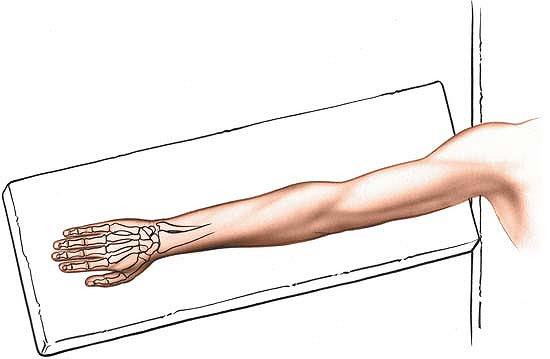 |
Figure 5-1 Place the patient supine on the operating table. Turn the forearm downward and place the arm on a board, for the dorsal approach to the wrist joint. |
Palpate the ulnar styloid on the dorsal aspect of the distal end of the ulna.
Incision
Make an 8-cm longitudinal incision on the dorsal aspect of the wrist, crossing the wrist joint midway between the radial and ulnar styloids. The incision begins 3 cm proximal to the wrist joint and ends about 5 cm distal to it. It can be lengthened if necessary (Fig. 5-2).
Because the skin on the dorsum of the wrist is pliable and redundant, the incision does not cause a contracture of the wrist joint, even though it crosses a major skin crease at right angles.
Internervous Plane
There is no true internervous plane, because both the extensor carpi radialis longus muscle and the extensor carpi radialis brevis muscle are supplied by the radial nerve. Because both muscles receive their nerve supply well proximal to the incision, however, the intermuscular plane between them can be used safely.
Superficial Surgical Dissection
Incise the subcutaneous fat in line with the skin incision to expose the extensor retinaculum that covers the tendons in the six compartments on the dorsal aspect of the wrist (Fig. 5-3).
Deep Surgical Dissection
The deep dissection depends on the procedure to be performed.
Synovectomy
Incise the extensor retinaculum over the extensor carpi radialis longus and brevis muscles in the second compartment of the wrist. The compartment is on the radial side of Lister’s tubercle. To expose the other compartments, incise the ulnar edge of the cut retinaculum by sharp dissection in an ulnar direction to deroof sequentially the four compartments on the ulnar side. Then, dissect the radial edge of the cut extensor retinaculum radially to deroof the first compartment. The extensor retinaculum should be preserved;
during closure, it can be sutured underneath the extensor tendons to prevent them from being abraded by the bones, which can be deformed grossly by rheumatoid arthritis (Fig. 5-8).
P.186
during closure, it can be sutured underneath the extensor tendons to prevent them from being abraded by the bones, which can be deformed grossly by rheumatoid arthritis (Fig. 5-8).
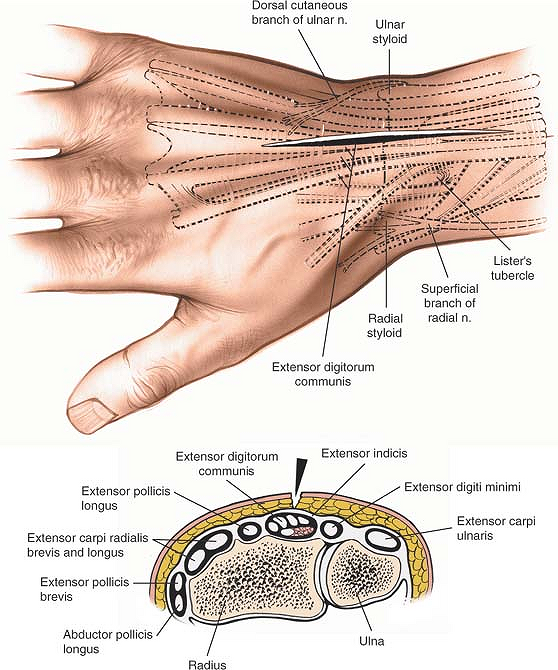 |
Figure 5-2 Skin incision for the dorsal approach to the wrist joint. A cross section at the distal portion of the radius is seen. |
Full Exposure of the Wrist Joint
Incise the extensor retinaculum over the extensor digitorum communis and extensor indicis proprius muscles in the fourth compartment of the wrist. Mobilize the tendons of the compartment, lifting them from their bed in an ulnar and radial direction to expose the underlying radius and joint capsule (Fig. 5-4). Incise the joint capsule longitudinally on the dorsal aspect of the radius and carpus (Fig. 5-5). Continue the dissection below the capsule (the dorsal radiocarpal ligament) toward the radial and ulnar sides of the radius to expose the entire distal end of the radius and carpal bones (Figs. 5-6 and 5-7).
The tendons of the extensor carpi radialis longus and brevis muscles, which attach to the bases of the second and third metacarpals and lie in a tunnel on the radial side of Lister’s tubercle, must be retracted radially to expose fully the dorsal aspect of the carpus.
P.187
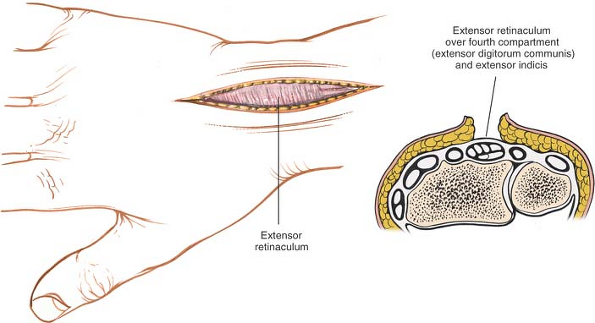 |
Figure 5-3 Skin flaps are developed, and the extensor retinaculum is visualized in the deeper portion of the wound. Cross section reveals the approach to the fourth tunnel, which contains the extensor digitorum communis and the extensor indicis proprius. |
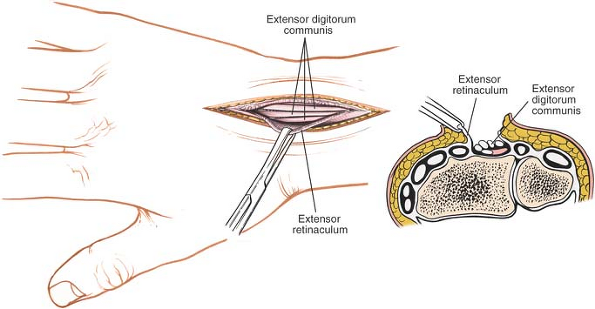 |
Figure 5-4 The retinaculum over the fourth compartment has been opened, revealing the communis tendons. |
P.188
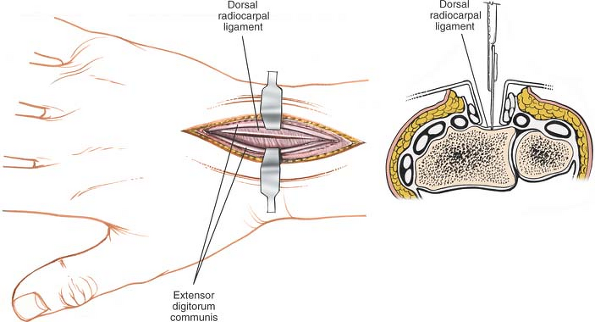 |
Figure 5-5 The extensor communis tendons and extensor indicis proprius have been retracted, revealing the dorsal radiocarpal ligament and the joint capsule, which then is incised. |
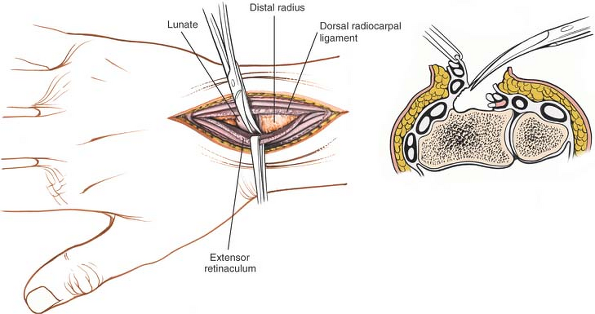 |
Figure 5-6 The dorsal radiocarpal ligament and the extensor tendons are elevated from the posterior aspect of the radius to expose the entire dorsal end of the bone. |
P.189
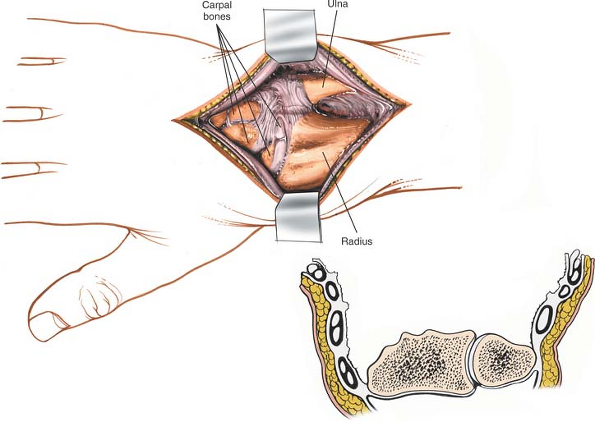 |
Figure 5-7 The extensor tendons in their compartments have been elevated to expose the distal end of the radius and ulna. |
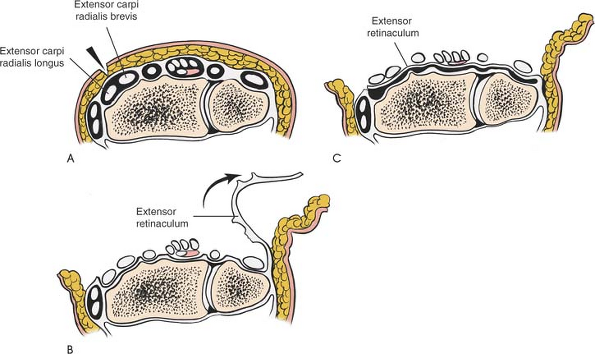 |
Figure 5-8 (A) For synovectomy, make an incision over the second compartment. (B) Open each of the compartments sequentially from radius to ulna by incising the septum that connects the retinaculum to the carpus itself and the joint capsule. (C) Now that the compartments have been deroofed, place the retinaculum between the extensor tendons and the distal ends of the radius and ulna to provide added protection for the tendons. |
P.190
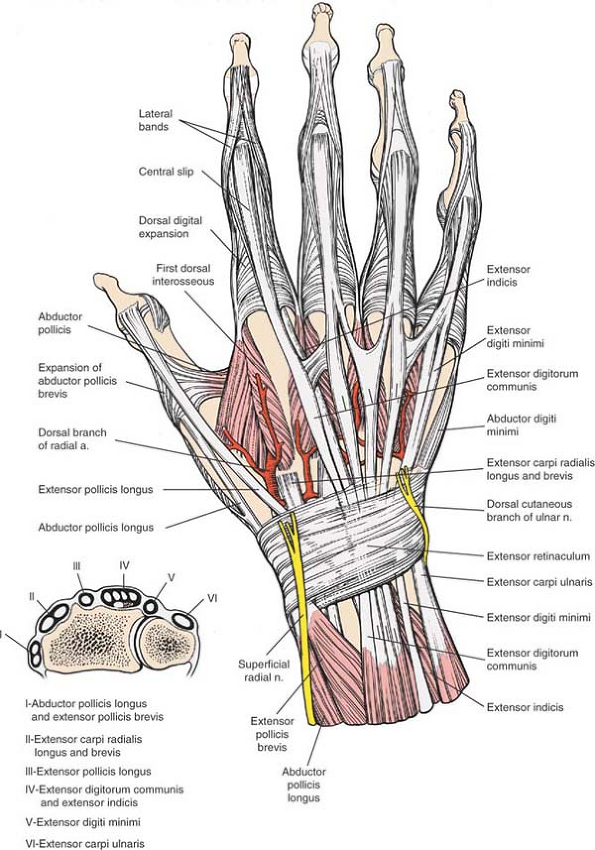 |
Figure 5-9 The dorsal aspect of the wrist and hand. Cross section of the distal forearm (inset). Note the compartmentalization of tendons into six distinct tunnels at the dorsal aspect of the distal forearm. |
P.191
Dangers
Nerves
The radial nerve (superficial radial nerve) emerges from beneath the tendon of the brachioradialis muscle just above the wrist joint before traveling to the dorsum of the hand. The skin incision lies between skin that is supplied by cutaneous branches of the ulnar nerve and skin that is supplied by cutaneous branches of the radial nerve. Damage to cutaneous nerves commonly occurs if the dissection of the flaps is begun within the fat layer. If the skin incision is taken down to the extensor retinaculum before the ulnar and radial flaps are elevated, the nerves are protected by the full thickness of the fat. Take care, however, to identify and preserve any nerve branches that are encountered during the incision of the subcutaneous tissue (Fig. 5-9).
Cutting a cutaneous nerve may result in a painful neuroma, but the resultant sensory defect rarely is significant.
Vessels
The radial artery crosses the wrist joint on its lateral aspect. As long as the dissection at the level of the wrist joint remains below the periosteum, the artery is difficult to damage.
How to Enlarge the Approach
Because it does not make use of an internervous plane, the incision cannot be extended proximally to expose the rest of the radius. It can be extended to expose the distal half of the dorsal aspect of the radius, however, by retracting the abductor pollicis longus and extensor pollicis brevis muscles, which cross the operative field obliquely.
To expose the entire dorsal surface of the metacarpals, extend the incision distally and retract the extensor tendons. (This type of extension seldom is required in practice.) The approach provides excellent exposure of the wrist joint and allows easy access to all six compartments of the extensor tunnel.
Applied Surgical Anatomy of the Dorsal Approach to the Wrist
Overview
Twelve tendons cross the dorsal aspect of the wrist joint and pass beneath the extensor retinaculum, which is a thickening of the deep fascia of the forearm. The extensor retinaculum prevents the tendons from “bowstringing.” Fibrous septa pass from the deep surface of the retinaculum to the bones of the forearm, dividing the extensor tunnel into six compartments. These septa must be separated from the retinaculum so that each compartment can be opened in surgery (see Fig. 5-9).
Landmarks and Incision
Landmarks
Two bony landmarks lie on the dorsal aspect of the wrist. The styloid process is the distal end of the lateral side of the radius. It also is the site of attachment of the tendon of the brachioradialis muscle. Its medial part articulates with the scaphoid bone (Fig. 5-12A). Strong and sudden radial deviation of the wrist may cause the radial styloid process to slam into the scaphoid and fracture it (see Fig. 5-12B). Alternatively, such a force may cause a fracture of the radial styloid.
The styloid process often is excised when the scaphoid fails to reunite or after arthritic changes in the wrist joint have affected the radial margin of the radioscaphoid joint.
Lister’s tubercle (the dorsoradial tubercle) is a small bony prominence on the dorsum of the radius. The tendon of the extensor pollicis longus muscle angles around its distal end, changing direction about 45° as it does so. When the wrist is hyperextended, the base of the third metacarpal comes very close to Lister’s tubercle, and the two bones can crush the trapped tendon of the extensor pollicis longus. This probably is the reason the tendon suffers delayed rupture in some cases of minimal or undisplaced fractures of the distal radius; the tendon sustains a vascular insult at the time of the original injury, even though it remains intact (see Fig. 5-12C).4
Incision
Longitudinal incisions crossing the lines of cleavage of the skin almost perpendicularly on the dorsum of the wrist can cause broad scarring. Nevertheless, because the skin on the wrist is so loose, this is one of those rare occasions when a skin incision can cross a major skin crease at right angles without causing a joint contracture.
P.192
Superficial and Deep Surgical Dissection
The extensor retinaculum is a narrow (2-cm) fibrous band that lies obliquely across the dorsal aspect of the wrist. Its radial side is attached to the anterolateral border of the radius; its ulnar border is attached to the pisiform and triquetral bones. (Were it attached to both bones of the forearm instead, pronation and supination would be impossible, because its fibrous tissue is incapable of stretching the necessary 30%.)
Fibrous septa pass from the deep surface of the extensor retinaculum to the bones of the carpus, dividing the extensor tunnel into six compartments (Fig. 5-10). From the radial (lateral) to the ulnar (medial) aspect, the compartments contain the following:
Abductor pollicis longus and extensor pollicis brevis. These tendons lie over the lateral aspect of the radius. They may become trapped or inflamed beneath the extensor retinaculum in their fibroosseous canal, producing de Quervain’s disease (tenosynovitis stenosans).
Extensor carpi radialis longus and extensor carpi radialis brevis. These muscles run on the radial side of Lister’s tubercle before reaching the dorsum of the hand. The tendon of the extensor carpi radialis longus is used frequently in tendon transfers. The tendons run in separate synovial sheaths.
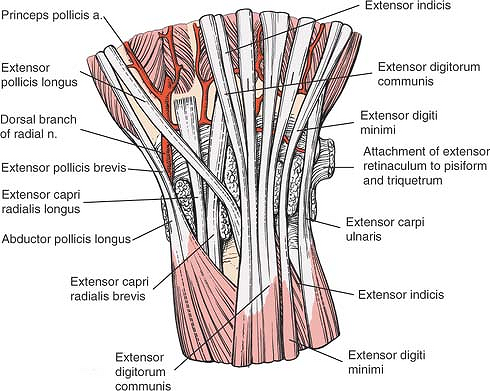
Figure 5-10 Anatomy of the distal forearm, with the extensor retinaculum excised and the septa remaining. The retinaculum on the ulnar side inserts into the triquetrum and pisiform bones.
Extensor pollicis longus. This tendon passes into the dorsum of the hand on the ulnar side of Lister’s tubercle. It may rupture in association with fractures or rheumatoid arthritis. The oblique passage of this tendon on the dorsal aspect of the wrist creates significant problems for plate fixation of fractures of the distal radius. Tendon irritation and even rupture may occur due to abrasion of the tendon on the surface of the plate. Similar problems apply to a lesser degree with all the other extensor tendons.6
Extensor digitorum communis and extensor indicis. The indicis tendon is used commonly in tendon transfers.
Extensor digiti minimi. This tendon overlies the distal radioulnar joint.
Extensor carpi ulnaris. This tendon passes near the base of the ulnar styloid process. It is used sometimes in tendon transfers (Fig. 5-11; see Fig. 5-10).
P.193
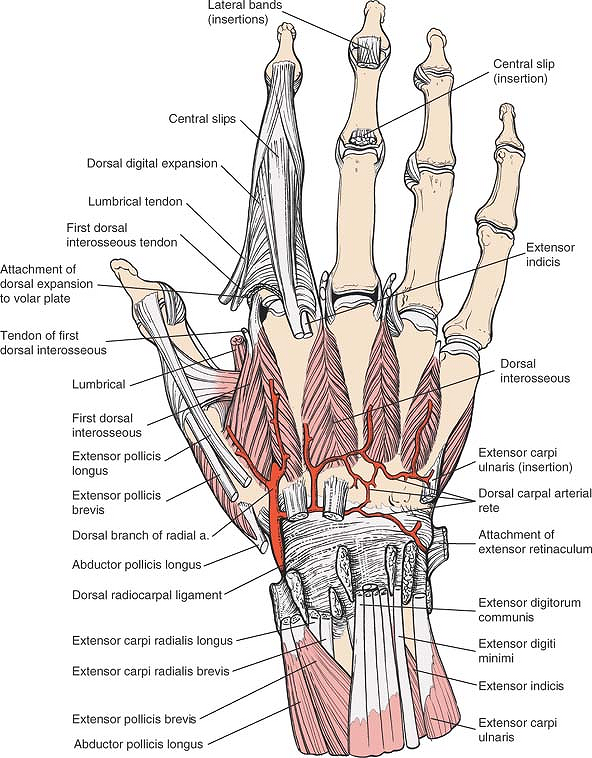 |
Figure 5-11 The extensor tendons have been removed, revealing the dorsal radiocarpal ligament. The radial artery is seen piercing the first dorsal interosseous muscle and contributing to the dorsal carpal rete. Note the hood mechanism for the index finger; contributions are made to it by the first dorsal interosseous and the first lumbrical muscles. |
P.194
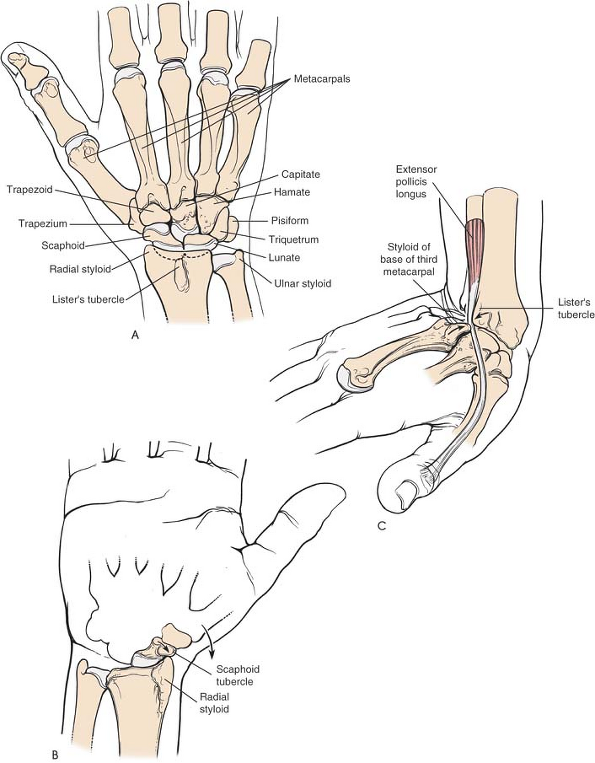 |
Figure 5-12 (A) Dorsal aspect of the bones of the distal forearm, wrist, and proximal hand. (B) A strong and sudden radial deviation of the wrist may cause the radial styloid process to impinge on the scaphoid tubercle and fracture it. (C) With sudden extreme dorsiflexion of the wrist, as when one falls on an outstretched hand, the extensor pollicis longus tendon may be trapped or crushed between the dorsal radial tubercle (Lister’s tubercle) and the base of the third metacarpal. |
P.195
Volar Approach to the Wrist
Decompression of the median nerve within the carpal tunnel is one of the most common operations of the hand. Two anatomic structures, the motor and palmar cutaneous branches of the median nerve, determine how the tunnel is approached. Both structures vary considerably in the paths they take; they are so unpredictable that “blind” procedures, which are acceptable elsewhere, must be avoided. The tunnel must be decompressed through a full incision and under direct vision. The uses of the incision include the following:
Decompression of the median nerve7,8
Synovectomy of the flexor tendons of the wrist
Excision of tumors within the carpal tunnel
Repair of lacerations of nerves or tendons within the tunnel
Drainage of sepsis tracking up from the mid-palmar space
Open reduction and internal fixation of certain fractures and dislocations of the distal radius and carpus, including volar lip fractures of the radius
Position of the Patient
Place the patient supine on an operating table. Rest the forearm on a hand table in the supinated position so that the palm faces upward. Use an exsanguinating bandage (Fig. 5-13).
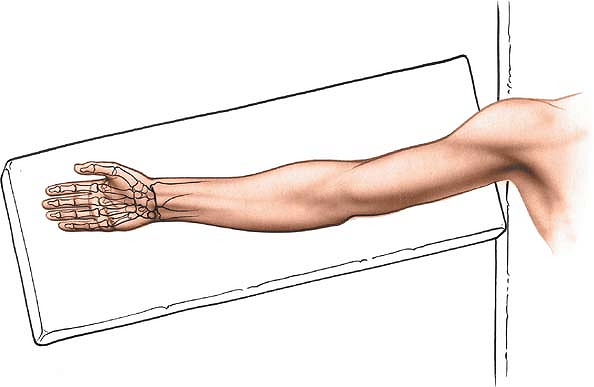 |
Figure 5-13 Position of the patient for volar approaches to the wrist and hand. |
Landmarks and Incision
Landmarks
The thenar crease runs around the base of the thenar eminence. The transverse skin crease of the wrist overlies the wrist joint. The tendon of the palmaris longus muscle bisects the anterior aspect of the wrist. Its distal end bisects the anterior surface of the carpal tunnel. It is easy to palpate in the distal forearm if the patient is instructed to pinch the fingers together and flex the wrist.
Incision
Begin the incision just to the ulnar side of the thenar crease, about one third of the way into the hand. Curve it proximally, remaining just to the ulnar side of the thenar crease, until the flexion crease of the wrist is almost reached: to avoid problems in skin healing, do not wander into the thenar crease itself. Then, curve the incision toward the ulnar side of the forearm so that the flexion crease is not crossed transversely (Fig. 5-14).
P.196
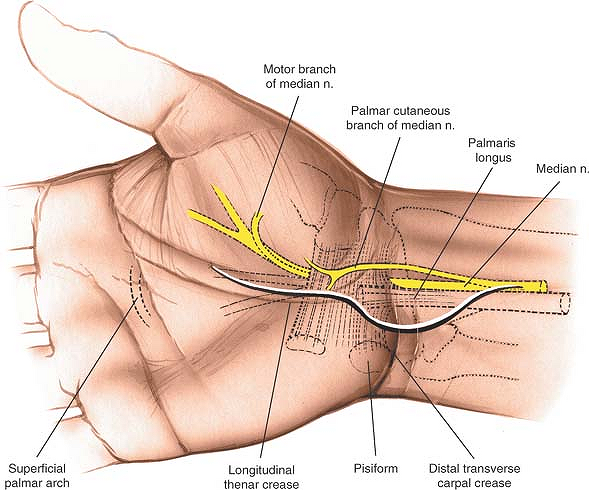 |
Figure 5-14 The incision for the volar approach to the wrist. The incision should be made on the ulnar side of the palmaris longus tendon to protect the palmar cutaneous branch of the median nerve. |
Internervous Plane
There is no internervous plane. The approach is a true anatomic dissection in which the major nerves are identified, dissected out, and preserved. No muscles are transected except, on occasion, some fibers of the abductor pollicis brevis and palmaris brevis that cross the midline.
Superficial Surgical Dissection
Carefully incise the skin flaps. Remember that the palmar cutaneous branch of the median nerve, which usually presents on the ulnar side of the flexor carpi radialis, has a variable course. Dissection should be carried out meticulously, with particular attention paid to the location of the nerve (see Fig. 5-14). After the fat is incised, the fibers of the superficial palmar fascia come into view; section them in line with the incision.
Retract the curved flaps medially, exposing the insertion of the palmaris longus muscle into the flexor retinaculum (the transverse carpal ligament; Fig. 5-15). Retract the tendon toward the ulna and identify the median nerve between the tendons of the palmaris longus muscle and the flexor carpi radialis muscle. The nerve lies closer to the palmaris longus than to the flexor carpi radialis (Fig. 5-16).
Pass a blunt, flat instrument (such as a McDonald dissector) down the carpal tunnel between the flexor retinaculum and the median nerve (Fig. 5-17). Carefully incise the retinaculum, cutting down on the dissector to protect the nerve. Make the incision on the ulnar side of the nerve to avoid possible damage to its motor branch to the thenar muscle. Divide the entire length of the retinaculum (Fig. 5-18).
P.197
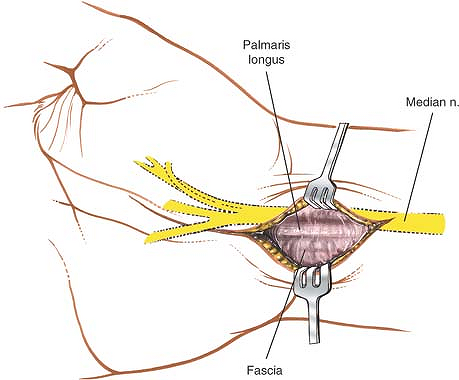 |
Figure 5-15 The skin is retracted, and the deep fascia and tendon of the palmaris longus are inspected. |
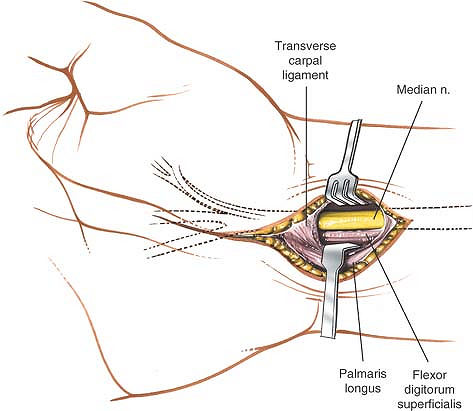 |
Figure 5-16 The deep fascia is incised. The palmaris longus is retracted toward the ulna, revealing the median nerve as it enters the carpal tunnel. |
P.198
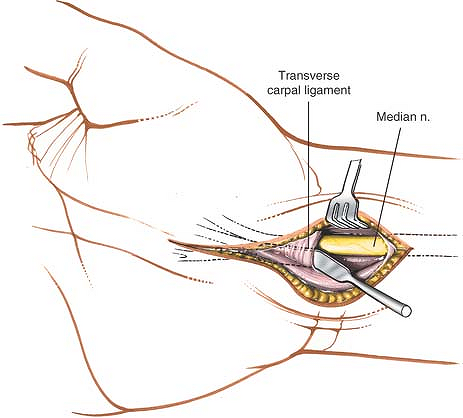 |
Figure 5-17 A spatula is placed under the transverse carpal ligament to protect the median nerve as the ligament is incised. |
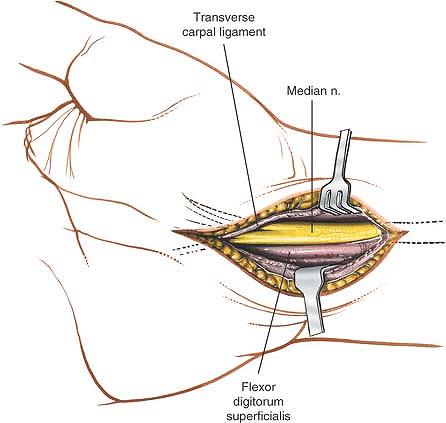 |
Figure 5-18 The transverse carpal ligament is released on the ulnar side of the nerve to avoid damage to the motor branch of the thenar muscle. |
P.199
Deep Surgical Dissection
Identify the motor branch of the median nerve. It usually arises from the anterolateral side of the median nerve just as the nerve emerges from the carpal tunnel. The motor branch then curves radially and upward to enter the thenar musculature between the abductor pollicis brevis and flexor pollicis brevis muscles. Sometimes, however, the motor branch arises within the tunnel and pierces the flexor retinaculum to reach the thenar musculature. In these rare cases, the motor nerve itself may have to be decompressed before the patient’s symptoms will be relieved fully (see Fig. 5-18).
It rarely is necessary to gain access to the volar aspect of the wrist joint. If this is required, mobilize the median nerve in the carpal tunnel and retract it radially to avoid stretching its motor branch. Next, mobilize and retract the flexor tendons in the carpal tunnel (Fig. 5-19). Incising the base of the tunnel longitudinally exposes the volar aspect of the carpus. Extending the incision proximally provides access to the volar aspect of the wrist joint and the distal radius (Fig. 5-20). The most convenient approach for access to the volar aspect of the distal radius is the distal portion of the anterior approach to the radius (see Chapter 4).
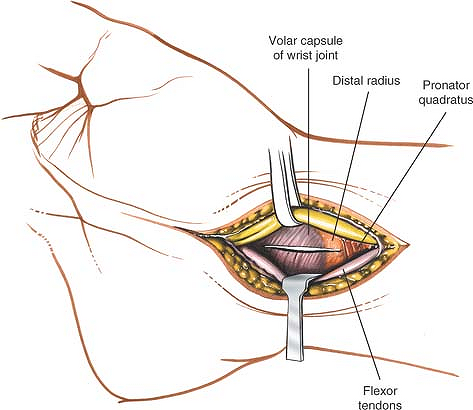 |
Figure 5-19 The median nerve is retracted radially and the flexor tendons are retracted toward the ulna, revealing the distal radius and joint capsule. An incision then is made into the capsule to expose the carpus. |
Dangers
Nerves
The palmar cutaneous branch of the median nerve arises 5 cm proximal to the wrist joint and runs down along the ulnar side of the tendon of the flexor carpi radialis muscle before crossing the flexor retinaculum. The greatest threat to this nerve occurs if the skin incision is not angled to the ulnar side of the forearm (see Fig. 5-14).
The motor branch of the median nerve to the thenar muscles exhibits considerable anatomic variation. The risk to the nerve is minimized if the incision is made into the carpal tunnel on the ulnar side of the median nerve (see Applied Surgical Anatomy of the Volar Aspect of the Wrist and Fig. 5-32).
Vessels
The superficial palmar arch crosses the palm at the level of the distal end of the outstretched thumb. Blind slitting of the flexor retinaculum may damage this arterial arcade if the instrument passes too far distally. The arch is in no danger if the flexor retinaculum is cut carefully under direct observation for its entire length (see Figs. 5-14 and 5-32). Minimal access approaches to divide the flexor retinaculum rely on arthroscopic visualization of the anatomical structures to ensure their preservation.
P.200
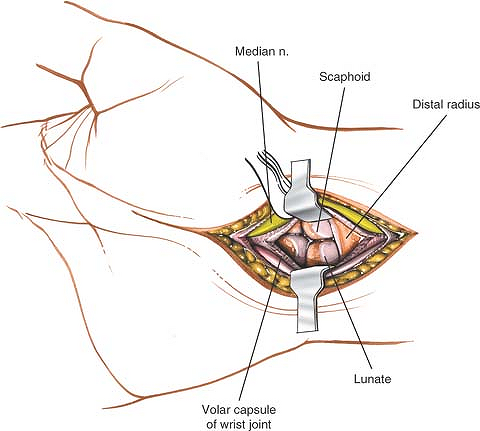 |
Figure 5-20 Incise the joint capsule to expose the carpus. |
How to Enlarge the Approach
Extensile Measures
Proximal Extension. The approach can be extended to expose the median nerve. To accomplish this, extend the skin incision proximally, running it up the middle of the anterior surface of the forearm (Fig. 5-21). Incise the deep fascia of the forearm between the palmaris longus and flexor carpi radialis muscles. Retract the flexor carpi radialis in a radial direction and the palmaris longus in an ulnar direction, exposing the muscle belly of the flexor digitorum superficialis muscle in the distal two
thirds of the forearm (Fig. 5-22). The median nerve adheres to the deep surface of the flexor digitorum superficialis, held there by fascia. Thus, if the flexor digitorum superficialis is reflected, the nerve goes with it (Fig. 5-23).
P.201
thirds of the forearm (Fig. 5-22). The median nerve adheres to the deep surface of the flexor digitorum superficialis, held there by fascia. Thus, if the flexor digitorum superficialis is reflected, the nerve goes with it (Fig. 5-23).
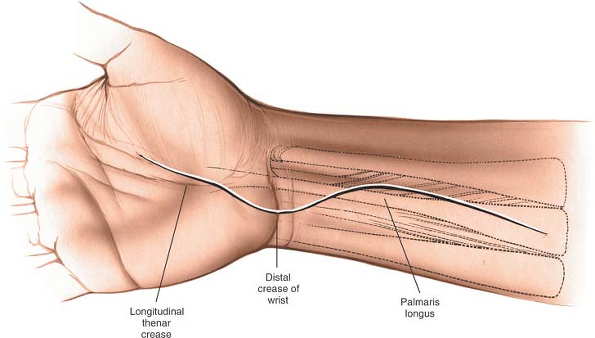 |
Figure 5-21 Extend the wrist incision proximally to expose the distal forearm and median nerve. |
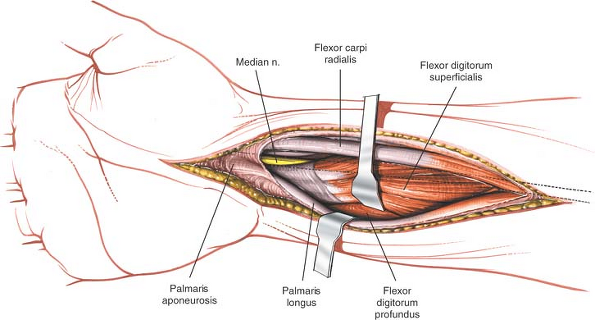 |
Figure 5-22 Incise the fascia on the forearm between the palmaris longus and the flexor carpi radialis to expose the tendons and muscles on the flexor digitorum superficialis. |
 |
Figure 5-23 Reflect the flexor digitorum superficialis and note that the median nerve moves with it, because it is attached to the muscle via the posterior fascia of the muscle. |
Distal Extension. The skin incision can be extended into a volar zigzag approach for any of the fingers, providing complete exposure of all the palmar structures (see Volar Approach to the Flexor Tendons and Fig. 5-38).
P.202
Volar Approach to the Ulnar Nerve
The volar approach is used for exploration of the ulnar nerve at the wrist. It is used primarily to decompress the canal of Guyon in cases of ulnar nerve compression. It also permits exploration of the ulnar nerve in cases of trauma. The approach is freely extensile proximally, allowing exposure of the nerve all the way up the forearm.
Position of the Patient
Place the patient supine on the operating table. Rest the hand on a hand table in the supinated position, so that the palm faces upward. Use an exsanguinating soft bandage, then inflate a tourniquet (see Fig. 5-13).
Landmarks and Incision
Landmarks
The hypothenar eminence is a readily palpable group of muscles on the ulnar border of the hand. The transverse skin crease of the wrist overlies the wrist joint.
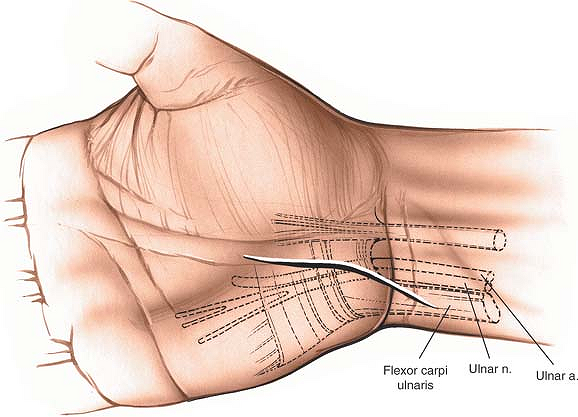 |
Figure 5-24 Incision for the exposure of the ulnar nerve in the canal of Guyon. |
Incision
Make a curved incision, following the radial border of the hypothenar eminence and crossing the wrist joint obliquely at about 60°. Extend the incision onto the volar aspect of the distal forearm. The incision should be about 5 to 6 cm long (Fig. 5-24).
Internervous Plane
There is no internervous plane. The approach is a true anatomic dissection in which the nerve and vessels are dissected out and preserved.
Superficial Surgical Dissection
Deepen the incision in the line of the skin incision and identify the tendon of the flexor carpi ulnaris in the proximal end of the wound (Fig. 5-25). Mobilize the tendon by incising the fascia on its radial border, and retract the muscle and tendon in an ulnar direction to reveal the ulnar nerve and artery (Fig. 5-26).
P.203
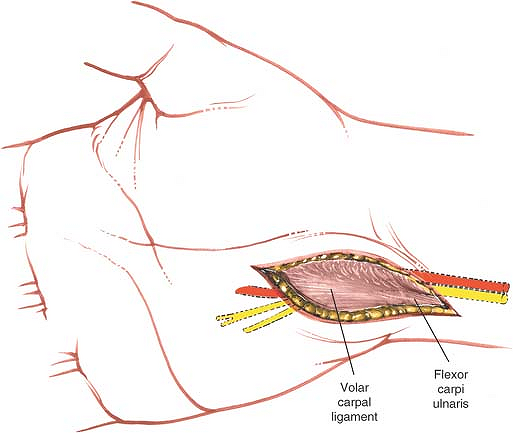 |
Figure 5-25 The volar carpal ligament is seen as a continuation of the deep palmar fascia and fibers of the flexor carpi ulnaris. |
 |
Figure 5-26 The volar carpal ligament is isolated and the nerve is protected in preparation for sectioning of the volar carpal ligament. |
P.204
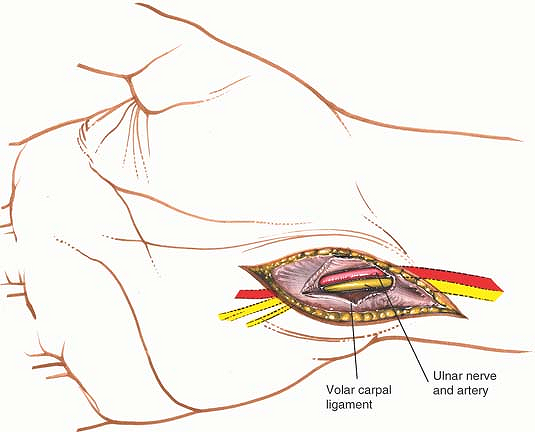 |
Figure 5-27 The roof of the canal has been incised, revealing the ulnar nerve and artery. |
Deep Surgical Dissection
Trace the nerve and artery distally, incising overlying fibrous tissue, the volar carpal ligament. During this procedure, take great care to protect the nerve and vessel. The ulnar nerve now is exposed across the wrist joint; the canal of Guyon is decompressed (Fig. 5-27).
Dangers
Nerves
The ulnar nerve is vulnerable during two phases of the dissection:
When the fascia on the radial side of the flexor carpi ulnaris is incised to allow retraction of the muscle, during superficial surgical dissection
When the volar carpal ligament is incised, during deep surgical dissection
If care is taken during these two phases of the procedure, the nerve should be safe.
How to Enlarge the Approach
Extensile Measures
Proximal Extension. Extend the skin incision proximally on the anterior aspect of the forearm, running it longitudinally up the middle of the forearm (Fig. 5-28). Incise the deep fascia in line with the incision and identify the radial border of the flexor carpi ulnaris. Develop a plane between the flexor carpi ulnaris muscle (which is supplied by the ulnar nerve) and the flexor digitorum superficialis muscle (which is supplied by the median nerve), retracting the flexor carpi ulnaris toward the ulna to reveal the ulnar nerve. This incision can expose the ulnar nerve almost to the level of the elbow joint (Fig. 5-29), where it passes between the two heads of the flexor carpi ulnaris muscle.
P.205
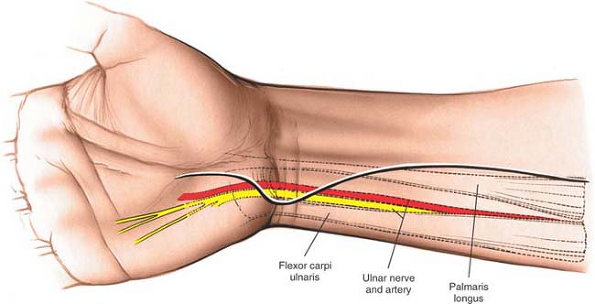 |
Figure 5-28 Explore the ulnar nerve proximally in the forearm. |
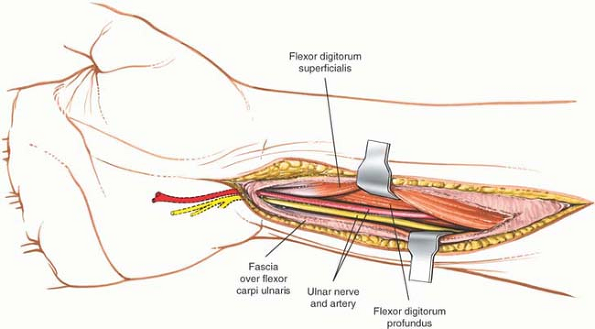 |
Figure 5-29 Develop the plane between the flexor carpi ulnaris and the flexor digitorum superficialis. In the depth of the wound, the ulnar nerve is visualized running under the reflected head of the flexor carpi ulnaris. |
P.206
Applied Surgical Anatomy of the Volar Aspect of the Wrist
Overview
The carpal tunnel is a fibro-osseous canal on the volar surface of the carpus. Its base is formed by the deeply concave surface of the volar aspect of the carpal bones, and its roof is formed by the flexor retinaculum (Fig. 5-30). The ulnar nerve runs over the surface of the flexor retinaculum; it is enclosed in its own fibro-osseous canal, the canal of Guyon (Fig. 5-31).
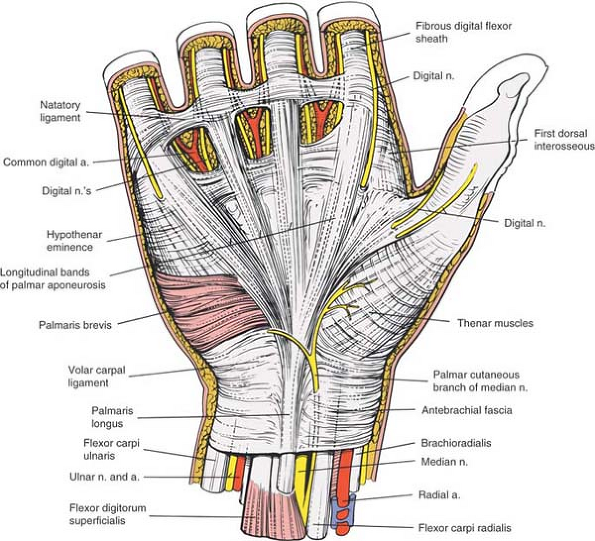 |
Figure 5-30 Superficial anatomy of the wrist and palm. Note the course of the cutaneous branch of the median nerve. The longitudinal bands of the palmar aponeurosis are continuations of the palmaris longus tendon. |
Landmarks and Incision
The four attachments of the flexor retinaculum all are palpable (Figs. 5-35 and 5-36A):
The pisiform. This is located on the ulnar border of the wrist. The pisiform is a mobile sesamoid bone lying within the tendon of the flexor carpi ulnaris muscle. The bone was sometimes used by artisans to tap nails into soft wood or leather.
P.207
P.208
Stress fractures have been noted in cobblers who use the pisiform for this purpose.
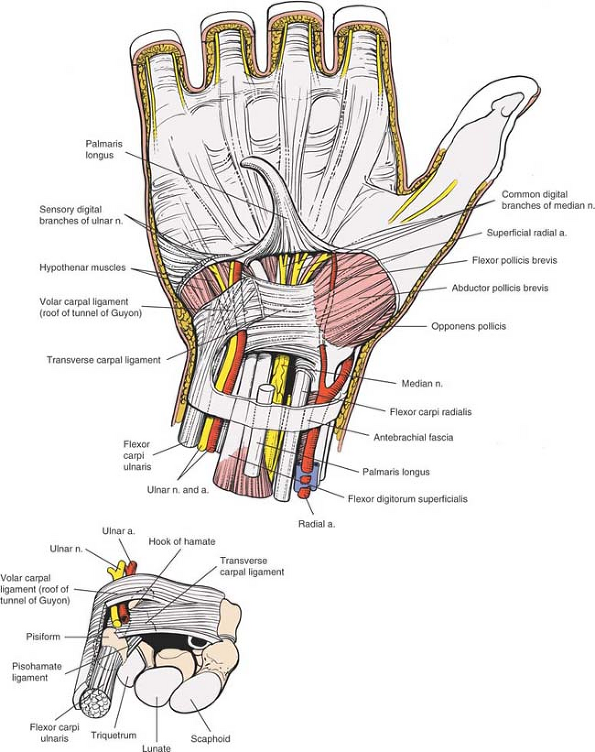
Figure 5-31 The palmar aponeurosis and fascia have been elevated to reveal the transverse carpal ligament. The fascia of the forearm and the expansions of the flexor carpi ulnaris (volar carpal ligament) are left intact where they form the roof of the tunnel of Guyon. The canal of Guyon looking from proximal to distal (inset). The transverse carpal ligament forms the floor of the tunnel of Guyon; the roof is formed by the volar carpal ligament, which is a condensation of the fascia of the forearm and expansions of the flexor carpi ulnaris tendon. The canal is formed medially by the pisiform bone and laterally by the hook of the hamate bone.
The hook of the hamate. This is slightly distal and radial to the pisiform. To locate it, place the interphalangeal joint of the thumb on the pisiform, pointing the tip toward the web space between the thumb and index finger, and rest the tip of the thumb on the palm. The hook of the hamate lies directly under the thumb. Because it is buried under layers of soft tissue, one must press firmly to find its rather shallow contours. The deep branch of the ulnar nerve lies on the hook, and neurapraxia of the nerve has been described in cases of fracture.
The ridge of the trapezium. The trapezium lies on the radial side of the carpus, where it articulates with the first metacarpal. To palpate the ridge, identify the joint between the trapezium and the thumb’s metacarpal bone by moving the joint passively. The ridge feels like a prominent lump on the volar aspect of the trapezium (see Fig. 5-36A).
The tubercle of the scaphoid. This small protuberance is barely palpable just distal to the distal end of the radius on the volar aspect of the wrist joint (see Figs. 5-35 and 5-36A).
On its radial side, the retinaculum also attaches across the groove on the trapezium, converting the groove into a tunnel through which the tendon of the flexor carpi radialis muscle runs before it attaches to the base of the second and third metacarpals (see Figs. 5-35 and 5-36A).
Superficial Surgical Dissection and its Dangers
Three structures run across the surface of the flexor retinaculum (see Fig. 5-30):
Tendon of the palmaris longus. The palmaris longus is a vestigial muscle of no functional importance. Its tendon is used frequently for tendon grafting. It is important to test for the presence of this tendon before surgery, because it is absent in about 10% of the population. The tendon also is used as an anatomic landmark for the injection of steroid into the carpal tunnel. If the patient is asked to flex the wrist against resistance, the tendon of the palmaris longus (if it is present) is easily palpable together with the thicker and more radially located tendon of the flexor carpi radialis. The easily defined gap between the two tendons is the site where the needle should be inserted for injection of the carpal tunnel. The needle should be inserted here dorsally and distally at an angle of almost 45°. Note also that because the carpal tunnel is a distensible space, if problems are encountered in injecting it, then the tip of the needle either is still in the flexor retinaculum or is imbedded in one of the tendons in the tunnel. Correctly positioned syringes should enter the space without encountering much resistance to pressure.
Palmar cutaneous branch of the median nerve. The course of the palmar cutaneous branch of the median nerve may vary in four important ways (see Fig. 5-30):
Normally, the nerve branches off 5 cm proximal to the wrist. It runs along the ulnar side of the tendon of the flexor carpi radialis before crossing the flexor retinaculum. On rare occasions, the nerve actually may be enclosed by parts of the flexor retinaculum and, thus, may run in a tunnel of its own on the wrist.
The nerve divides into two major branches, medial and lateral, while crossing the flexor retinaculum. The lateral is the larger branch. Both supply the skin of the thenar eminence.
Less often, the nerve arises from the median nerve in two distinct branches, which travel separately across the wrist.9
The palmar cutaneous branch may arise within the carpal tunnel and penetrate the flexor retinaculum to supply the skin of the thenar eminence.
The palmar cutaneous branch may be absent, replaced by a branch derived from the radial nerve, the musculocutaneous nerve, or the ulnar nerve.9
The skin incision described above avoids cutting the nerve by angling across the distal forearm in an ulnar direction. One must be aware, however, that considerable variability exists in the course of the nerve. Because damage can result in the formation of a painful neuroma, transverse incisions on the volar aspect of the distal forearm must be avoided. (Compression lesions of the nerve have been reported, but these are rare.)10,11
Ulnar nerve. The ulnar nerve runs down the volar surface of the distal forearm under cover of the flexor carpi ulnaris muscle (see Fig. 5-31). The ulnar artery lies on its radial side. The tendon of the flexor carpi ulnaris inserts into the pisiform, which then joins with the hamate and fifth metacarpal via ligaments. Just proximal to the wrist, the artery and nerve emerge from under the muscle to pass over the flexor retinaculum (the transverse carpal ligament) of the wrist (see Fig. 5-31).
At this level, the anatomic arrangement of these structures can be remembered by the mnemonic “ANT”: the artery is the most lateral structure, then
the nerve, and, finally, the tendon of the flexor carpi ulnaris (see Fig. 5-31).
P.209
the nerve, and, finally, the tendon of the flexor carpi ulnaris (see Fig. 5-31).
At the wrist, the nerve is particularly vulnerable to damage by lacerations. The grim triad of lacerations of the tendon of the flexor carpi ulnaris, the ulnar artery, and the ulnar nerve is a common sequela of falling through a window with the ulnar border of the wrist flung forward to protect the face.
As the nerve crosses the flexor retinaculum, it is covered with a tough fibrous tissue that is continuous with the deep fascia of the forearm, the volar carpal ligament. The tunnel thus formed, the canal of Guyon, has four boundaries: a floor, the flexor retinaculum (transverse carpal ligament); a medial wall, the pisiform; a lateral wall, the hamate; and a roof, the volar carpal ligament (distal fascia of the forearm; see Fig. 5-31).
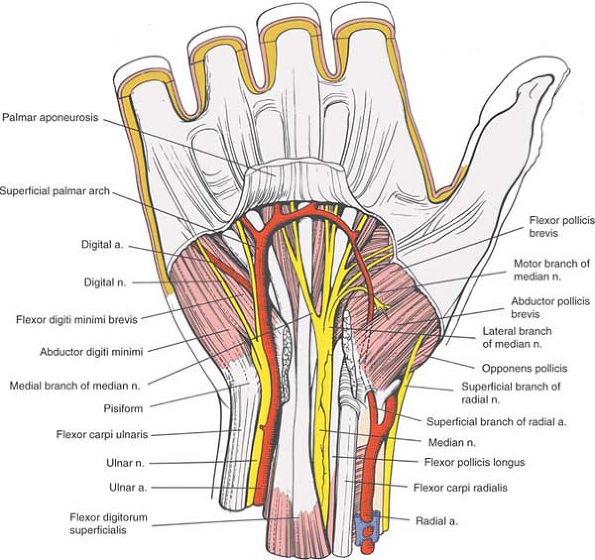 |
Figure 5-32 The palmar aponeurosis has been resected further distally to expose the superficial palmar arterial arch. The transverse carpal ligament also has been resected. The median nerve lies superficial to the tendons of the profundus, but at the same level with the superficialis muscle tendons. Note the motor branch of the median nerve to the thenar muscles. The location of its division from the median nerve is quite variable. |
Around the pisiform, the ulnar nerve divides into two branches. The superficial branch supplies the palmaris brevis muscle and the skin of the small finger and ulnar half of the ring finger. The deep branch supplies all the small intrinsic muscles of the hand, except those of the thenar eminence and the radial two lumbricals (see Figs. 5-32, 5-33, 5-34 and 5-35).
P.210
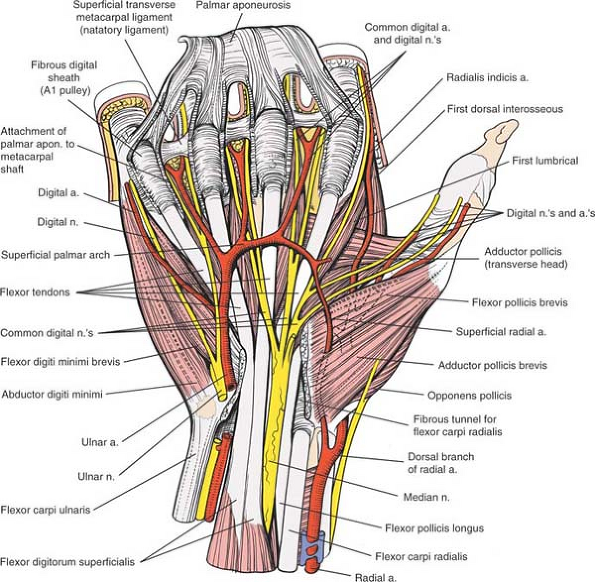 |
Figure 5-33 The palmar aponeurosis has been elevated up to its attachment to the digital flexor sheaths. Its deeper attachments to the carpal plate and bone have been cut. The flexor tendons and digital nerves are shown in continuity, as are the superficial palmar arch and the thenar and hyperthenar muscles. Note that the digital nerves and vessels go deep or dorsal to the natatory ligaments. Flexor Pollicis Brevis. Origin. Flexor retinaculum. Insertion. Radial border of proximal phalanx of thumb. Action. Flexor of metacarpophalangeal joint of thumb. Nerve supply. Median nerve (motor or recurrent branch). Abductor Pollicis Brevis. Origin. Flexor retinaculum and tubercle of scaphoid. Insertion. Radial side of base of proximal phalanx of thumb. Action. Abduction of thumb at metacarpophalangeal joint and rotation of proximal phalanx of thumb. Nerve supply. Median nerve (motor or recurrent branch). |
P.211
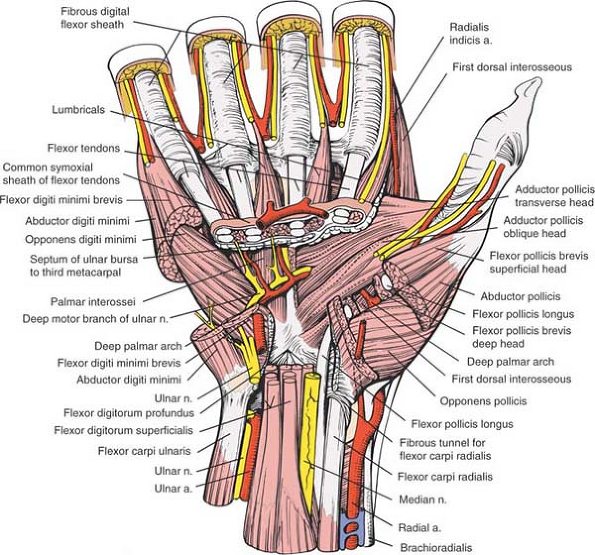 |
Figure 5-34 Portions of the thenar and hypothenar muscles have been resected to reveal their layering. The ulnar nerve passes between the origin of the abductor digiti minimi and the flexor digiti minimi. In the thenar region, the course of the flexor pollicis longus is seen as it crosses between the two heads of the flexor pollicis brevis. Portions of the long flexors of the fingers have been resected to show their layering. The superficial palmar arch runs superficial to the tendons, whereas the deep palmar arch is immediately deep to the tendons. Note that potential spaces develop on the undersurface of the flexor tendons and their sheaths, and on the deep intrinsic muscles of the hand, the interosseous on the hyperthenar side and the adductor pollicis on the thenar side. A septum that runs from the undersurface of the flexor tendons to the third metacarpal divides the two spaces. More distally, the superficial transverse ligament has been resected, revealing the course of the lumbricals and the digital vessels that run superficial or palmar to the deep transverse metacarpal ligaments. Adductor Pollicis. Origin. Oblique head from bases of second and third metacarpals, trapezoid, and capitate. Transverse head from palmar border of third metacarpal. Insertion. Ulnar side of base of proximal phalanx of thumb via ulnar sesamoid. Action. Adduction of thumb. Opposition of thumb. Nerve supply. Deep branch of ulnar nerve. Opponens Pollicis. Origin. Flexor retinaculum. Insertion. Radial border of thumb metacarpal. Action. Opposition of metacarpal bone of thumb. Nerve supply. Median nerve (motor or recurrent branch). |
P.212
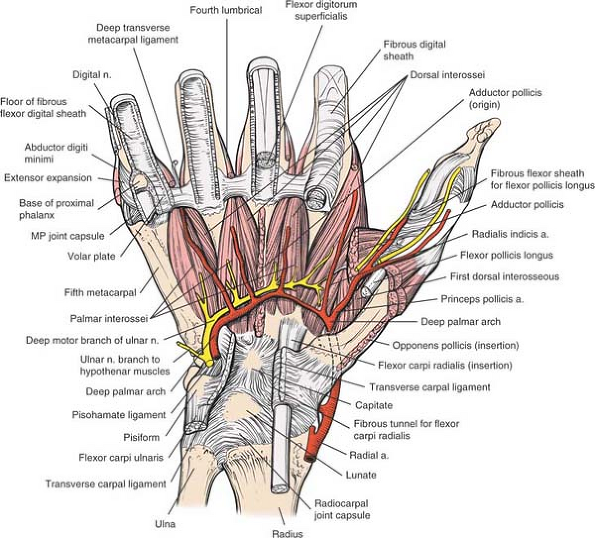 |
Figure 5-35 The deepest layer of the palm is revealed. The deep palmar arterial arch lies deep to the long flexor tendon and superficial to the interosseous muscles. It crosses the palm with the deep branch (motor branch) of the ulnar nerve. The nerve supplies all the interosseous muscles. More distal, the interosseous muscles are seen running deep (dorsal) to the deep transverse ligament. The deep transverse metacarpal ligaments attach to the palmar plate, which is seen on the fifth metacarpal. The pulleys of the thumb are seen in relationship to the digital nerves. |
Deep Surgical Dissection and its Dangers
Median Nerve
The median nerve crosses the volar aspect of the distal forearm deep to the flexor digitorum superficialis muscle. Just above the wrist, it becomes superficial and lies between the tendons of the palmaris longus and flexor carpi radialis muscles. It enters the palm by traversing the carpal tunnel (see Fig. 5-31).
Within the tunnel, the nerve lies superficial to the tendons of the flexor digitorum profundus and flexor
pollicis longus muscles. The superficialis tendons lie toward the ulnar side of the nerve. At the distal border of the flexor retinaculum, the nerve divides into two branches (see Figs. 5-32 and 5-33).
P.213
pollicis longus muscles. The superficialis tendons lie toward the ulnar side of the nerve. At the distal border of the flexor retinaculum, the nerve divides into two branches (see Figs. 5-32 and 5-33).
The medial branch sends cutaneous branches to the adjacent sides of the ring and middle fingers, and to the adjacent sides of the middle and index fingers.
The lateral branch sends cutaneous branches to the radial side of the index finger and to both sides of the thumb. The lateral branch usually also sends off the motor, or recurrent, nerve (see Fig. 5-32), which is the key surgical landmark and major surgical danger in carpal tunnel decompression.
The motor nerve supplies the muscles of the thenar eminence. Its course may take any one of seven significant variations10:
The classic course (seen in 50% of patients). The branch arises from the volar radial aspect of the median nerve distal to the radial end of the carpal tunnel. The nerve hooks radially and upward to enter the thenar muscle group between the flexor pollicis brevis and abductor pollicis brevis muscles.
The position of the motor branch can be estimated by drawing one vertical line from the web space between the middle and index fingers, drawing another from the radial origin of the first web space, then connecting to the hook of the hamate (Kaplan’s cardinal line). The intersection of these two lines marks the origin of the motor branch (see Fig. 5-36B).12
A variation that occurs in about 30% of patients. The branch arises from the anterior surface of the nerve within the carpal tunnel. It passes through the tunnel with its parent nerve and hooks around the distal end of the flexor retinaculum to enter the thenar group between the flexor pollicis brevis and abductor pollicis brevis muscles.
A variation that occurs in about 20% of patients. The branch arises from the anterior surface of the nerve within the carpal tunnel. It travels radially to pierce the flexor retinaculum and enter the thenar group of muscles between the abductor pollicis brevis and flexor pollicis brevis muscles.13
A rare variation. The branch arises from the ulnar side of the median nerve.14 It crosses the median nerve within the tunnel, then hooks around the distal end of the flexor retinaculum to enter the thenar muscle group. It also may pass through the flexor retinaculum and lie anterior to it.15
Another rare variation. The nerve arises from the anterior surface of the median nerve within the carpal tunnel. At the distal end of the flexor retinaculum, the branch hooks radially over the top of the retinaculum. The nerve crosses the distal part of the retinaculum almost transversely before entering the thenar group of muscles.
Stay updated, free articles. Join our Telegram channel

Full access? Get Clinical Tree








